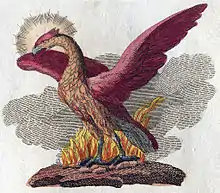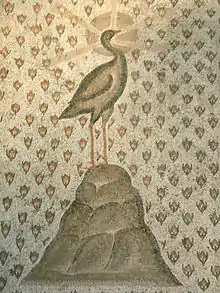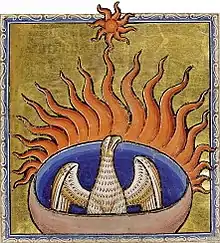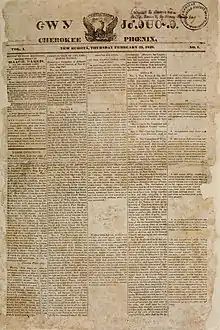Phoenix (mythology)
In ancient Greek folklore, a phoenix (/ˈfiːnɪks/; Ancient Greek: φοῖνιξ, phoînix) is a long-lived bird that cyclically regenerates or is otherwise born again. Associated with the sun, a phoenix obtains new life by arising from the ashes of its predecessor. Some legends say it dies in a show of flames and combustion, others that it simply dies and decomposes before being born again.[1] In the Motif-Index of Folk-Literature, a tool used by folklorists, the phoenix is classified as motif B32.[2]

Over time the phoenix motif spread from its origins in classical folklore and gained a variety of new associations: Herodotus, Lucan, Pliny the Elder, Pope Clement I, Lactantius, Ovid, and Isidore of Seville are among those who have contributed to the retelling and transmission of the phoenix motif. Over time, extending beyond its origins in classical Greek folklore, the phoenix could variously "symbolize renewal in general as well as the sun, time, the Empire, metempsychosis, consecration, resurrection, life in the heavenly Paradise, Christ, Mary, virginity, the exceptional man, and certain aspects of Christian life".[3]
Etymology
The modern English word phoenix enters the English language from Latin, later reinforced by French. The word first enters the English language by way of a borrowing of Latin phoenīx into Old English (fenix). This borrowing was later reinforced by French influence, which had also borrowed the Latin noun. In time, the word developed specialized use in the English language: For example, the term could refer to an "excellent person" (12th century), a variety of heraldic emblem (15th century), and the name of a constellation (17th century).[4]
The Latin word comes from Greek φοῖνιξ phoinīx.[5] The Greek word is first attested in the Mycenaean Greek po-ni-ke, which probably meant 'griffin', though it might have meant 'palm tree'. That word is probably a borrowing from a West Semitic word for madder, a red dye made from Rubia tinctorum. The word Phoenician appears to be from the same root, meaning 'those who work with red dyes'. So phoenix may mean 'the Phoenician bird' or 'the purplish-red bird'.[6]
Early texts
Exterior to the Linear B mention above from Mycenean Greece, the earliest clear mention of the phoenix in ancient Greek literature occurs in a fragment of the Precepts of Chiron, attributed to 6th century BC Greek poet Hesiod. In the fragment, the wise centaur Chiron tells a young hero Achilles the following:[7]
Classical discourse on the subject of the phoenix attributes a potential origin of the phoenix to Ancient Egypt. Herodotus, writing in the 5th century BC, provides the following account of the phoenix:[8]
[The Egyptians] have also another sacred bird called the phoenix which I myself have never seen, except in pictures. Indeed it is a great rarity, even in Egypt, only coming there (according to the accounts of the people of Heliopolis) once in five hundred years, when the old phoenix dies. Its size and appearance, if it is like the pictures, are as follow: The plumage is partly red, partly golden, while the general make and size are almost exactly that of the eagle. They tell a story of what this bird does, which does not seem to me to be credible: that he comes all the way from Arabia, and brings the parent bird, all plastered over with myrrh, to the temple of the Sun, and there buries the body. In order to bring him, they say, he first forms a ball of myrrh as big as he finds that he can carry; then he hollows out the ball and puts his parent inside, after which he covers over the opening with fresh myrrh, and the ball is then of exactly the same weight as at first; so he brings it to Egypt, plastered over as I have said, and deposits it in the temple of the Sun. Such is the story they tell of the doings of this bird.
In the 19th century, scholastic suspicions appeared to be confirmed by the discovery that Egyptians in Heliopolis had venerated the Bennu, a solar bird similar in some respects to the Greek phoenix. However, the Egyptian sources regarding the bennu are often problematic and open to a variety of interpretations. Some of these sources may have actually been influenced by Greek notions of the phoenix, rather than the other way around.[9]
Depictions


The phoenix is sometimes pictured in ancient and medieval literature and medieval art as endowed with a halo, which emphasizes the bird's connection with the Sun.[13] In the oldest images of phoenixes on record these nimbuses often have seven rays, like Helios (the Greek personification of the Sun).[14] Pliny the Elder[15] also describes the bird as having a crest of feathers on its head,[13] and Ezekiel the Dramatist compared it to a rooster.[16]
The phoenix came to be associated with specific colors over time. Although the phoenix was generally believed to be colorful and vibrant, sources provide no clear consensus about its coloration. Tacitus says that its color made it stand out from all other birds.[17] Some said that the bird had peacock-like coloring, and Herodotus's claim of the Phoenix being red and yellow is popular in many versions of the story on record.[18] Ezekiel the Tragedian declared that the phoenix had red legs and striking yellow eyes,[16] but Lactantius said that its eyes were blue like sapphires[19] and that its legs were covered in yellow-gold scales with rose-colored talons.[20]
Herodotus, Pliny, Solinus, and Philostratus describe the phoenix as similar in size to an eagle,[21] but Lactantius and Ezekiel the Dramatist both claim that the phoenix was larger, with Lactantius declaring that it was even larger than an ostrich.[22]
According to Pliny's Natural History,[23]
aquilae narratur magnitudine, auri fulgore circa colla, cetero purpureus, caeruleam roseis caudam pinnis distinguentibus, cristis fauces, caputque plumeo apice honestante. |
The story is that it is as large as an eagle, and has a gleam of gold round its neck and all the rest of it is purple, but the tail blue picked out with rosecoloured feathers and the throat picked out with tufts, and a feathered crest adorning its head. |
| —Pliny the Elder,"Naturalis historia", X: 2 | —translated by Harris Rackham, 1940, LCL: 353, pp. 292–294 |
According to Claudian's poem "The Phoenix",[24]
arcanum radiant oculi iubar. igneus ora |
A mysterious fire flashes from its eye, |
| —Claudian,"Phoenix", ll. 17–22 | —translated by Henry Maurice Platnauer, 1922, LCL: 136, pp. 224–225 |

Appearances
According to Pliny the Elder, Marcus Manilius had written that the phoenix appeared at the end of each Great Year, which he took to have occurred "in the consulship of Gnaeus Cornelius and Publius Licinius", that is, in 96 BC.[23] Another of Pliny's sources, Cornelius Valerianus, is cited for an appearance of the phoenix in 36 AD "in the consulship of Quintus Plautius and Sextus Papinius".[23] Pliny states that a purported phoenix seen in Egypt in 47 AD was brought to the capital and exhibited in the Comitium in time for the 800th anniversary of the foundation of Rome by Romulus, though he added that "nobody would doubt that this phoenix was a fabrication".[23]
Diffusion in later culture
In time, the motif and concept of the phoenix extended from its origins in ancient Greek folklore. For example, the classical motif of the phoenix continues into the Gnostic manuscript On the Origin of the World from the Nag Hammadi Library collection in Egypt generally dated to the 4th century:[26]
Thus when Sophia Zoe saw that the rulers of darkness had laid a curse upon her counterparts, she was indignant. And coming out of the first heaven with full power, she chased those rulers out of their heavens and cast them into the sinful world, so that there they should dwell, in the form of evil spirits upon the earth.
[...], so that in their world it might pass the thousand years in paradise—a soul-endowed living creature called "phoenix". It kills itself and brings itself back to life as a witness to the judgement against them, for they did wrong to Adam and his race, unto the consummation of the age. There are [...] three men, and also his posterities, unto the consummation of the world: the spirit-endowed of eternity, and the soul-endowed, and the earthly. Likewise, there are three phoenixes in paradise—the first is immortal, the second lives 1,000 years; as for the third, it is written in the sacred book that it is consumed. So, too, there are three baptisms—the first is spiritual, the second is by fire, the third is by water. Just as the phoenix appears as a witness concerning the angels, so the case of the water hydri in Egypt, which has been a witness to those going down into the baptism of a true man. The two bulls in Egypt posses a mystery, the Sun and the Moon, being a witness to Sabaoth: namely, that over them Sophia received the universe; from the day that she made the Sun and Moon, she put a seal upon her heaven, unto eternity. And the worm that has been born out of the phoenix is a human being as well. It is written concerning it, "the just man will blossom like a phoenix". And the phoenix first appears in a living state, and dies, and rises again, being a sign of what has become apparent at the consummation of the age.


The anonymous 10th century Old English Exeter Book contains an anonymous 677-line 9th-century alliterative poem consisting of a paraphrase and abbreviation of Lactantius, followed by an explication of the Phoenix as an allegory for the resurrection of Christ.[27]
Þisses fugles gecynd fela gelices |
This bird's nature is much like |
| —In the original Old English | —In Modern English translation (1842)[28] |
In the 14th century, Italian poet Dante Alighieri refers to the phoenix in Inferno Canto XXIV:
Così per li gran savi si confessa |
Even thus by the great sages 'tis confessed |
| —In the original Italian | —In English translation |
In the 17th century play Henry VIII by English playwrights William Shakespeare and John Fletcher, Archbishop Cranmer says in Act V, Scene v in reference to Elizabeth (who was to become Queen Elizabeth I):
... Nor shall this peace sleep with her; but as when
The bird of wonder dies, the maiden phoenix,
Her ashes new create another heir
As great in admiration as herself;
So shall she leave her blessedness to one,
When heaven shall call her from this cloud of darkness,
Who from the sacred ashes of her honour
Shall star-like rise as great in fame as she was,
And so stand fix'd ...
Phoenixes are present and relatively common in European heraldry, which developed during the High Middle Ages. They most often appear as crests, and more rarely as charges. The heraldic phoenix is depicted as the head, chest and wings of an eagle rising from a fire; the entire creature is never depicted.[29]
In modern era popular culture

In the modern era, the phoenix motif continues to see use in a variety of contexts. Elon University's sports teams became known as the Phoenix in 2000, stemming from the colleges fire and subsequent recovery in 1923. University trustees at the time announced their intentions to make Elon "rise from the ashes".
Swarthmore College's newspaper has been named "The Phoenix" since the college's fire in 1881;[30] the phoenix bird was considered emblematic of the college's rebirth from its ashes. More recently, "Phineas the Phoenix" has become the official mascot[31] of Swarthmore College, with a dancing student inside a costume of plush plumage.
The flag of San Francisco features a phoenix in its center, symbolic of the city's rebuilding following the 1906 San Francisco earthquake.
The club crest of Coventry City Football Club features a phoenix rising from the flames, in recognition of how the City of Coventry was rebuilt after being destroyed by the Nazi German Luftwaffe during the Blitz bombing campaigns of World War II.
Coventry University use a phoenix rising from the flames as their emblem, tying in with the city they are based, and the same reason Coventry City Football Club carry a phoenix on their club crest.
Analogues
Scholars have observed analogues to the phoenix in a variety of cultures. These analogues include the Hindu garuda (गरुड) and bherunda (भेरुण्ड), the Russian firebird, the Persian simorgh (سیمرغ), the Georgian paskunji, the Arabian anqa (عنقاء), the Turkish Konrul, also called Zümrüdü Anka ("emerald anqa"), the Tibetan Me byi karmo, the Chinese Fenghuang (鳳凰) and Zhuque (朱雀), and the Japanese Hō-ō (鳳凰).[32] These perceived analogues are sometimes included as part of the Motif-Index of Folk-Literature phoenix motif (B32).[2]
See also
- Chalkydri
- Chol (Bible), a Hebrew word sometimes glossed as phoenix
Notes
- Van der Broek 1972, p. 146.
- Thompson (2001: 581).
- Van der Broek 1972, p. 9.
- "phoenix, n.1". OED Online. September 2020. Oxford University Press. https://www.oed.com/view/Entry/142601?rskey=BIj1L3&result=1&isAdvanced=false (accessed November 06, 2020).
- Barnhart 1995, p. 564.
- Van der Broek 1972, p. 62–66.
- Evelyn-White (1920: 75-75).
- Herodotus, The Histories (1858 translation), Book II Trans. G. Rawlinson (1858)
- Van der Broek 1972, p. 14–25.
- "coin | British Museum". The British Museum. Retrieved 2021-01-27.
- Poole, Reginald Stuart (1892). Catalogue of Greek Coins in the British Museum: Alexandria and the Nomes (PDF). London: British Museum Publications. pp. 117, No. 1004.
- Rackham, H., ed. (1940), Pliny. Natural History, Volume III: Books 8-11, Loeb Classical Library 353, translated by Rackham, H., Cambridge, MA: Harvard University Press, p. 293, doi:10.4159/DLCL.pliny_elder-natural_history.1938
- Van der Broek 1972, p. 233.
- Van der Broek 1972, pp. 246–247.
- Ancient Magic and the Supernatural in the Modern Visual and Performing Arts, edited by Filippo Carlà-Uhink, Irene Berti, 2016, page 172
- Van der Broek 1972, p. 257.
- Van der Broek 1972, p. 253.
- Van der Broek 1972, p. 259.
- Van der Broek 1972, p. 256.
- Van der Broek 1972, pp. 257–258.
- Van der Broek 1972, p. 251.
- Van der Broek 1972, p. 252.
- Rackham, H., ed. (1940), Pliny. Natural History, Volume III: Books 8-11, Loeb Classical Library 353, translated by Rackham, H., Cambridge, MA: Harvard University Press, pp. 292–294, doi:10.4159/DLCL.pliny_elder-natural_history.1938
- Loeb Claudian Volume II (1922), Platnauer, M. (ed.), translated by Platnauer, M., "Claudian: Shorter Poems: "Phoenix"", Claudian: On Stilicho's Consulship 2-3. Panegyric on the Sixth Consulship of Honorius. The Gothic War. Shorter Poems. Rape of Proserpina, Loeb Classical Library 136, Cambridge, MA: Harvard University Press, pp. 222–231, doi:10.4159/DLCL.claudian_claudianus-shorter_poems.1922
- Lepetoukha, Charlotte. "Œuvre: Mosaïque du phénix". Musée du Louvre. Retrieved 2021-01-28.
- James M. Robinson (1988). The Nag Hammadi Library. pp. 291-292. HarperCollins Publishers.
- Blake 1964, p. 1.
- Thorpe, Benjamin; Corson, Hiram (1842). "Codex exoniensis. A collection of Anglo-Saxon poetry, from a manuscript in the library of the dean and chapter of Exeter". p. 244. Retrieved 9 December 2018.
- Arthur Fox-Davies, A Complete Guide to Heraldry, T.C. and E.C. Jack, London, 1909, 240, https://archive.org/details/completeguidetoh00foxduoft.
- "1882 The Phoenix Founded". www.swarthmore.edu. 2016-05-13. Retrieved 2020-01-03.
- "The Phoenix". www.swarthmore.edu. 2014-07-08. Retrieved 2020-01-03.
- Garry & El-Shamy 2005, pp. 84–87.
References
- Barnhart, Robert K (1995), The Barnhart Concise Dictionary of Etymology, HarperCollins, ISBN 0-06-270084-7.
- Blake, N F (1964), The Phoenix, Manchester: Manchester U Press.
- Evelyn-White, Hugh G. Trans. 1920. Hesiod: The Homeric Hymns and Homerica. London: William Heinemann & New York: G.P. Putnam's Sons.
- Garry, Jane; El-Shamy, Hasan (2005), Archetypes and Motifs in Folklore and Literature, ME Sharpe, ISBN 978-0-76561260-1.
- Thompson, Stith. 2001. Motif-Index of Folk-Literature: A Classification of Narrative Elements in Folk Tales, Ballads, Myths, Fables, Mediaeval Romances, Exempla, Fabliaux, Jest-Books, and Local Legends, Volume 1; Volume 6. Indiana University Press. 9780253340894
- Van der Broek, R (1972), The Myth of the Phoenix, Seeger, I trans, EJ Brill.
